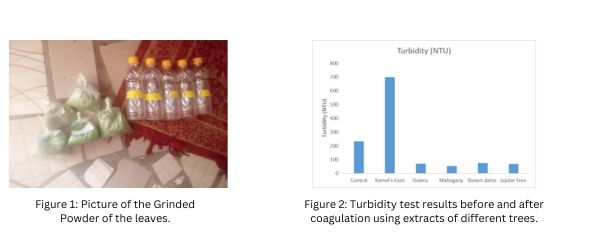COAGULATION POTENTIALS OF THE LEAVES OF DESERT DATES, GUIERA, JUJUBE TREE, KAMEL’S FOOT AND MAHOGANY
DOI:
https://doi.org/10.26662/ijiert.v11i1.pp68-73Keywords:
Water, Coagulation, Turbidity, LeavesAbstract
Coagulation activity in water and waste water treatment tends to reduce turbidity by agglomerating the dissolved and suspended particles thereby making them dense enough to settle. Alluminium phosphate is the common solution that is used to achieve coagulation. In case of lacking aluminum phosphate, an alternative has to be considered. In this study, leaves of five trees are considered. The trees include Jujube Tree (Prunus Domestica), Desert dates (Balanites Eagyptiaca), Kamel’s Foot (Piliostigma reticulatum; P. Thonningii), Guiera (Guiera Senegalensis) and Mahogany (Khaya Senegalensis). Leaves of these trees were dried and grinded to powder before they were dissolved in water. Extract of these solution were used for coagulation potentialities with a concentration of 2 ml per liter. Turbidity of the water was tested before coagulation and was found to be 233 NTU. The results of the turbidity after coagulation showed that the water has 53 NTU, 69 NTU, 70 NTU, 74 NTU and 700 NTU for Mahogany, Jujube, Guiera, Desert Dates and Kamel’s Foot respectively. Drinking water limit of 5NTU for turbidity in accordance to W.H.O has not been achieved in all the tests made

Downloads
Published
Issue
Section
License

This work is licensed under a Creative Commons Attribution-NonCommercial-NoDerivatives 4.0 International License.
Under the Creative Commons Attribution-NonCommercial-NoDerivatives 4.0 International License (CC BY-NC-ND 4.0 DEED).
You are free to:
- Share — copy and redistribute the material in any medium or format
- The licensor cannot revoke these freedoms as long as you follow the license terms.
Under the following terms:
- Attribution — You must give appropriate credit , provide a link to the license, and indicate if changes were made . You may do so in any reasonable manner, but not in any way that suggests the licensor endorses you or your use.
- NonCommercial — You may not use the material for commercial purposes .
- NoDerivatives — If you remix, transform, or build upon the material, you may not distribute the modified material.
- No additional restrictions — You may not apply legal terms or technological measures that legally restrict others from doing anything the license permits.
Notices:
You do not have to comply with the license for elements of the material in the public domain or where your use is permitted by an applicable exception or limitation .
No warranties are given. The license may not give you all of the permissions necessary for your intended use. For example, other rights such as publicity, privacy, or moral rights may limit how you use the material.
Rights of Authors
Authors retain the following rights:
1. Copyright and other proprietary rights relating to the article, such as patent rights,
2. the right to use the substance of the article in future works, including lectures and books,
3. the right to reproduce the article for own purposes, provided the copies are not offered for sale,
4. the right to self-archive the article.

